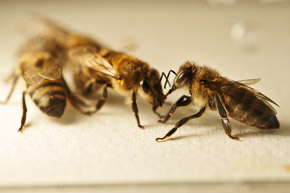M
Determination of neonicotinoid residues in bees by liquid chromatography coupled with tandem mass spectrometry (LC-MS/MS)
A.C. Martel (1), C. Lair
(1) ANSES, Sophia Antipolis Laboratory (France)
A.C. Martel, C. Lair (2012). Determination of neonicotinoid residues in bees by liquid chromatography coupled with tandem mass spectrometry (LC-MS/MS), EuroReference, No. 6, ER06-12M01. http://www.ansespro.fr/euroreference/numero6/PN80I0.htm
The method for determining neonicotinoid residues in bees was developed and validated by the Sophia Antipolis laboratory in 2008 (associated National Reference Laboratory (NRL) for pesticides in food of animal origin and commodities with high fat content, and associated NRL for the analysis of pesticide residues using single residue methods). The laboratory thus has a very sensitive and rapid method for detecting the possible involvement of these insecticides in cases of weakening and mortality of bee colonies.
Principle of the method
The pesticides sought (thiamethoxam, clothianidin, acetamiprid, thiacloprid and imidacloprid) are chemical substances used in agriculture, and belong to the family of neonicotinoids (Figure 1). The coating of seeds with contact or systemic pesticides is used in agriculture against soil pests and to protect seedlings and plants from pests. Other pesticides are applied to crops as a foliar spray. Neonicotinoid residues can be found in different compartments of the environment. Consequently, bees, which are biomarkers of the health of the environment, may come into contact with these residues (AFSSA report, 2008).
The method for determining levels of these five insecticides toxic to bees (Table 1) is based on extraction with acetonitrile and liquid/liquid partition with hexane, followed by a clean up on solid-phase Florisil® cartridge. The extract obtained after evaporation is recovered with ultra pure water in order to be injected and analysed by liquid chromatography coupled with tandem mass spectrometry (LC-ESI-MS/MS). This multi-residue analytical method can identify and quantify the neonicotinoid residues in the "bee" matrix. The limit of quantification (LOQ) is 0.05 ng/bee for all pesticides except acetamiprid, whose LOQ is 0.1 ng/bee.
Equipment and reagents
The specific equipment includes (1) an Ultra-Turrax® T25 homogeniser (IKA) for grinding the bees, (2) a TurboVap II (Caliper LifeSciences) evaporation station under gas stream to concentrate the extracts, (3) a liquid chromatograph with autosampler and injection loop of 20 µl (Surveyor HPLC System, ThermoFinnigan) coupled to a triple quadrupole mass spectrometer equipped with an ESI source (TSQ Quantum, ThermoFinnigan).
All solvents used (acetone, hexane, petroleum ether, and dichloromethane) are of "trace analysis” quality. For LC-ESI-MS/MS analysis, LC-MS grade methanol and formic acid (98%) are used. The measurement standards are prepared from certified active material ordered from CIL Cluzeau Info Labo: thiamethoxam (99% purity), clothianidin (99.5%), acetamiprid (99%), thiacloprid (99.5%) and imidacloprid (98%). The certified solution of dimethoate-D6 (99.8% purity, 100 mg/l in acetone) also comes from CIL Cluzeau Info Labo.
Procedure
1. Extraction
The bee sample (2 g, 20 insects) is weighed in a centrifuge tube of 50 ml, and 100 µl of the internal standard extraction (dimethoate-D6) is added to the bee sample. The bee sample is then homogenised with 30 ml of acetonitrile, using an Ultra-Turrax®. The extract is filtered through a Büchner funnel. The sample is re-extracted with 30 ml of acetonitrile and filtered. The final extract is transferred to a separating funnel of 500 ml. The liquid/liquid separation is performed by adding 50 ml of hexane in the funnel. After shaking, two phases are obtained: the lower phase (acetonitrile) is recovered in the vacuum flask, and the upper phase (hexane) is eliminated. The liquid/liquid separation is repeated on the lower phase by adding a further 50 ml of hexane. After shaking, the acetonitrile phase is collected in a Zymark tube (200 ml) and evaporated to dryness at 40°C under air flow, using the evaporation station (TurboVap II). The extract is taken up in 2 ml of dichloromethane for clean up.
2. Clean up
The Florisil® cartridge (1g, 6ml, Phenomenex) is conditioned with 10 ml of dichloromethane. Next, the sample is deposited, then washed with 20 ml of a mixture of petroleum ether/dichloromethane 80:20 (v/v). Elution of the pesticides is performed with 20 ml of a mixture of acetonitrile/dichloromethane 95:5 (v/v). The eluate is transferred to a Zymark tube and evaporated to 0.2 ml at 40° C under air flow, using the TurboVap II. The volume of the final extract is adjusted to 1 ml with ultra pure water. After vortexing, the extract is filtered through a Millex filter (PVDF, 0.45 µm, Millipore) and injected into the LC-ESI-MS/MS.
3. Measurement
3.1. High Performance Liquid Chromatography (HPLC)
Chromatographic separation is carried out with a Pursuit PFP analytical column, 100 x 3 mm (3 µm) (Varian). The mobile phase consists of ultra pure water (A) and methanol (B), each solution being acidified with 0.02% formic acid. Insecticides are separated using a gradient elution, as follows: linear gradient from 80% A (at t = 0 min) to 0% (at t = 13 min), then linear gradient of 0% A (at t = 13 min) to 80% (at t = 16 min), and holding at 80% A for 9 min. The column and autosampler are thermostated at 25° C, the flow rate is 0.4 ml/min, and the injection volume is 20 µl.
3.2. Mass spectrometry
The ionisation source used is electrospray in positive mode (ESI +). The divert valve is set to allow the admission of the mobile phase in the source between 4.50 min and 12 min. The mass analyser is a triple quadrupole, and the collision gas is argon. The acquisition mode used is the SRM mode (Selected Reaction Monitoring). Transitions and retention times are presented in Table 2, and chromatograms obtained in Figure 2.
Results and Conclusion
Calibration is performed using a range extracted from the "bees" matrix (blank and fortified samples). The linear dynamic range is defined as the area of calibration and has been validated up to 20 µg/l for each pesticide and up to 40 µg/l for acetamiprid.
The limits of detection (LOD) and quantification (LOQ) were respectively 0.015 ng/bee (0.15 µg/kg) and 0.05 ng/bee (0.5 µg/kg) for thiamethoxam, clothianidin, thiacloprid, and imidacloprid. The LOD and LOQ were respectively 0.03 ng/bee (0.3 µg/kg) and 0.1 ng/bee (1 µg/kg) for acetamiprid.
In the absence of reference material, the recovery rate was determined using a sample of bees (blank matrix) fortified with the analytes at two concentration levels (LOQ and 5LOQ). For each concentration level, five bee samples were extracted and analysed. Two other series of five samples were also carried out. The mean recoveries obtained are satisfactory in terms of regulatory requirements (SANCO Document, 2010) because, at the LOQ, they are between 93.3% and 102.7%, and between 94.7% and 104.0% for samples spiked at 5LOQ (Martel, 2011). The method is repeatable and reproducible as the relative standard deviations (RSD) were ≤ 20% for each concentration level.
A series of additional analyses were conducted to determine the value of the "real" recovery, a value independent of the matrix. This test was performed at three concentration levels (LOQ, 2LOQ and 5LOQ) by comparing the peak area of analyte and the internal standard obtained in a set (set 1 corresponding to a spiking before sample extraction), compared to those obtained in another set (set 2 corresponding to a spiking after extraction). Recoveries were determined by comparing the ratios obtained in sets 1 and 2 (Matuszewski, 2003). These were between 70 and 120%.
This method makes it possible to quantify residues at levels below the LD50 of each pesticide for bees. It can thus be applied to samples of bees collected during episodes of environmental pollution, of weakening and mortality of colonies.
Dosage des résidus de néonicotinoïdes dans les abeilles par chromatographie en phase liquide couplée à la spectrométrie de masse en tandem (LC-MS/MS)

Références
Afssa. 2008. Mortalités, effondrements et affaiblissements des colonies d'abeilles. Rapport, France : 218 p. [consulté le 13 mai 2011]
AGRITOX, 2011, Base de données sur les substances actives phytopharmaceutiques. [consulté le 13 mai 2011]
European Commission. Method validation and quality control procedures for pesticide residues analysis in food and feed, Document N° SANCO/10684/2009 (01/01/2010). [consulté le 13 mai 2011]
Martel A.C., Lair C. 2011. Validation of a highly sensitive method for the determination of neonicotinoid insecticides residues in honeybees by liquid chromatography with electrospray tandem mass spectrometry. International Journal of Environmental Analytical Chemistry, 91 (10) : 978-988.
Matuszewski B.K, Constanzer M.L, Chavez-Eng C.M. 2003. Strategies for the assessment of matrix effect in quantitative bioanalytical methods based on HPLC-MS/MS. Analytical Chemistry, 75 : 3019-3030.
Methods
Table 1. Toxicity of studied pesticides with respect to bees
(Agritox, 2011)
Figure 1. Chemical structures of the pesticides studied
Table 2. Transitions pesticides studied and associated retention times (for information)
Figure 2. Chromatograms (total ion current and extracted ion) obtained from LC-MS/MS for (A) the blank sample of bees, and for (B) the sample of bees fortified with pesticides at LOQ





